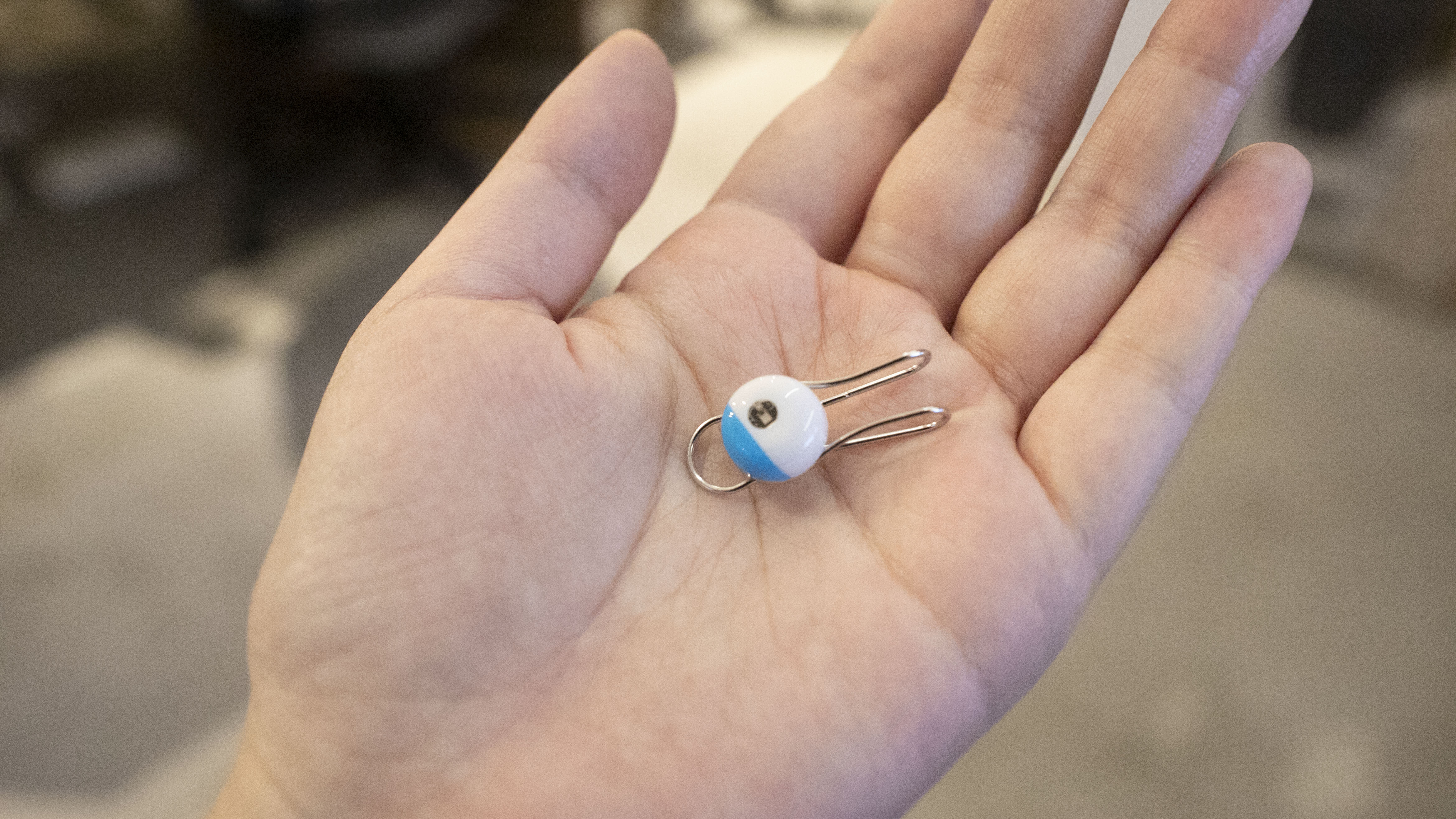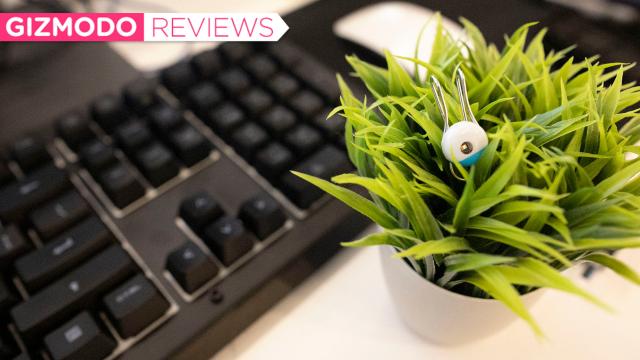Skin care is a multimillion dollar industry that ranges the gamut from slathering on snail mucin to plain old sunscreen. Knowing what type of product to use can be daunting, let alone what conditions require what lotion, balm, toner, or moisturiser.
Sometimes, good skin seems more witchcraft than science.
But My Skin Track by La Roche-Posay, a L’Oreal brand, is a tiny, wearable sensor that’s supposed to help demystify that process.
It measures your exposure to UV, pollution, pollen, and humidity, and with the help of an app, you can get personalised skin care tips and product recommendations (provided they’re all from La Roche-Posay).

My Skin Track by La Roche-Posay
What is it?
A small tracker that tracks your UV exposure
Price
$US60 ($85)
Like
Cute. Easy to use. No charging.
No like
Super easy to lose. I already know I need to moisturize.
The way it works is there’s a tiny LED inside the tracker that’s activated and powered by sunlight. You just clip it onto an article of clothing – like your collar, hat, or shoes – and go about your day. When you’re ready to find out just how many delicious UV rays you’ve blasted yourself with, you just hold it up to your phone’s NFC sensor to transmit the data. (You’ll need at least an iPhone 7 or Android phone from 2015 or later).
Because it’s solar powered, the sensor is battery free. Which is good as you’ll never need to charge it, and I don’t know where you would stick a battery in a device that’s only 0.47 inches wide and 0.24 inches thick. That’s way smaller than a quarter, and even my thumbnail.
The sensor itself looks like a small button that snaps into a metal clip. It’s pretty stylish and discreet, though it does stick out if you’re wearing dark clothing. It’s not quite as cool as when it was first introduced at CES 2018 as a neat sensor you could stick on your nail, but it is definitely more practical and cost-effective.
I clipped it to my sweater collar, shoes, and hat over the course of a week and found, for the most part, it stayed on pretty sturdily. I found it easiest and safest to wear on my shoes, as I didn’t really have to remember to wear it (hat) and it was guaranteed not to get covered up by my winter jacket.
But its smallness was also a double-edged sword. One night I took my sweater off too aggressively—it was a long day—and it went flying across the room. As this little baby costs $US60 ($85), I immediately spent a good 15 minutes crawling on my hands and knees, inhaling the rancid dust bunnies under my bed, trying to find it. I also threw it into the laundry hamper multiple times, only to dig through a mound of dirty clothes the next morning when I realised what I’d done.
Technically, the sensor is rated IP67 and should survive underwater for 30 minutes – but I would not trust it to survive a wash cycle at my laundromat. And as careful (for me) as I was, I could easily see myself losing the sensor within a month.
But hardware aside, the app is the real point of the sensor. When you initially pair the device, you’re prompted to input your skin type (e.g., oily, normal, dry, combination, etc.) and skin tone via a swatch that’s only slightly problematic in its limited range. (This is, after all, L’Oreal, not Fenty.
You will not find 40 shades in the My Skin Track app.)
Once you put in your info, you can then sync the tracker and view your UV exposure, weather conditions in your area, humidity, air quality level, and the pollen index.
Occasionally, you get reminders to sync the device throughout the day—L’Oreal recommends twice a day at the very least, and every two hours if you’re out in the sun. But as far as skin care recommendations go, I found the app lacking.
I already know I should moisturise. In the American winter (or the baking heat of the Australian summer), all I have to do is wake up and touch my scaly, pasty cheeks to know that I should moisturise. And while I can view my weekly exposure trends in the app, it feels like most of that is based on my profile and my phone’s location data than the information collected from the sensor.
At least the sensor is relatively accurate. I am a shrivelled blogger chained to a keyboard. The only natural light I get is the sickly glow of my computer screen, save for a few glorious minutes of walking from my apartment to the train station. The last time I got a physical, my doctor called my vitamin D levels “truly pathetic.”
The app reflected that with an extremely low UV exposure index of 1 and a weekly average of 0.5. Though, in an attempt to make sure this thing worked, I did make the effort to take daily 15-20 minute walks around Union Square and stand in a patch of sunlight. When you account for some cloudy days, this non-zero reading at least proves I got some sort of daylight.
But aside from one or two notifications that pollution levels were higher than average and that I should moisturise my face twice a day, the experience didn’t alert me to anything I didn’t already know. And really, the same would be true of anyone willing to shell out $US60 for a tracker that measures UV exposure.
Every child knows that if you don’t wear sunscreen to the beach, you’ll get sunburned. You can sort of tell what your UV exposure is … if you just go and spend any longer-than-average time outside.
If you’ve ever read one of those clickbaity “10 Skin Secrets to Looking as Dewy as [Insert Gorgeous Celebrity]” articles, you know that it’s all about drinking a metric ton of water and slathering a moisturizing sunscreen on on a daily basis.
What I wanted was a deeper analysis of how my environment would impact my specific skin type. Something like, “It’s dry and you spent 40 minutes outside today. You should use a clay mask and skip exfoliating tonight.”
And while there is no ethical consumption under capitalism, it is a little bit of an eye roll that the only recommended products offered in the app are La Roche-Posay.
I wouldn’t expect L’Oreal to hock Estee Lauder, Korean snail mucin, or Kiehls, but I know they’ve got way more than just La Roche-Posay.
I would love to glow like Rihanna, or look as poreless as Amber Heard in the new Aquaman film. I am deathly intimidated by 12-step Korean skin care regimens and have no idea what the difference between toner, serums, and ampoules are. But for $US60, this sensor hasn’t told me anything I don’t already know or changed how I approach my skin care regimen.
For the same price, I could walk into a Sephora, do my best approximation of the shrug emoji at a consultant, and walk away with at least a jar or two of some sort of goop to put on my face. And honestly, that seems like a better use of my money.
README
-
It works, in that it seemed to accurately tell me how much sun I was getting.
-
It did not work, in that it provided me with no new information.
-
It does suggest I moisturise, but it lacks details and only suggests stuff made by the same company.
-
It’s super tiny, which is great for hiding the sensor.
-
Yet, tiny also means easy to lose, and I forgot it on a piece of clothing many times.
